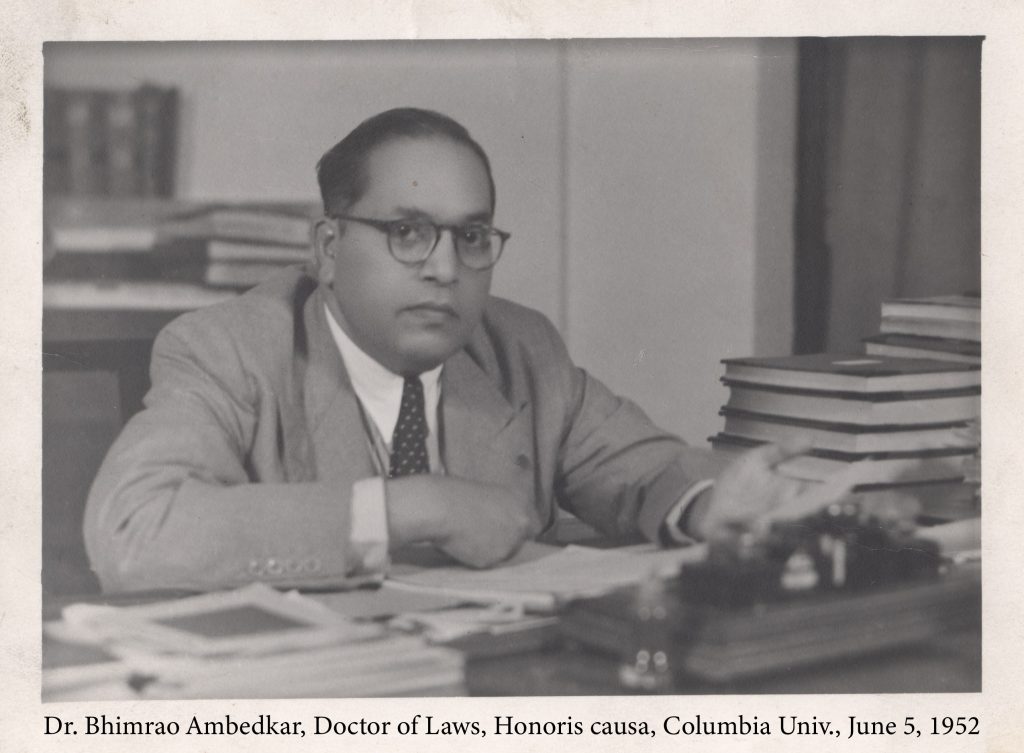


Ambedkar Jayanti (Bimbhao Ambedkar’s birthday), which takes place on April 14th, comes upon us this year in most unusual and harsh circumstances, when an enormous percentage of people across the planet is sheltered at home and the COVID-19 pandemic has taken the lives of tens of thousands. Under these unprecedented realities which expose the deeply entrenched inequalities in our societies and, sadly, put disadvantaged groups in an even more difficult situation, my mind is drawn to the legacy of Ambedkar– as the Chairman of the drafting committee for the Indian constitution, under the Constituent Assembly of India, the “Doctor and Saint” or as people affectionately refer to him, Baba Saheb Ambedkar (1891-1956)– and to his remarkable work on behalf of the Dalits and of the disadvantaged, and toward a just and equitable society. I think of his statue in the far east corner of Lehman Library at the Columbia University Libraries where I work, and I feel sad that no one can pay tribute there to a man who advocated for the Dalits and for women, for the under-represented and discriminated against, and who fought for justice and unity for all. No garlands will be laid this year, no one will gather there, no photos will be taken of visitors from across the globe posing in front of the bust and the small display of archival photos and documents, as has happened every year in the past. (For a touching account of one such visit to the Ambedkar bust in Lehman Library by an admirer of Ambedkar, and a health worker/doctor, please see the following post).
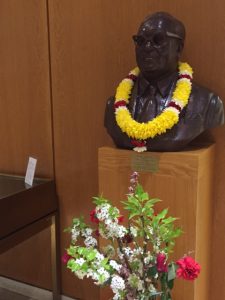
I find myself all the more appreciative of the statue in the Lehman Library and its significance as a representation of the effort to reclaim public space for virtue, equity, and fairness at a moment when one of the dear things we as individuals have lost is space and mobility, and when social institutions such as universities and libraries are struggling to maintain a public presence in support of such ideals and to nourish the aspiration for a better and more equitable world.
In her introduction to Ambedkar’s Annihilation of Caste, Arundhati Roy discusses statues of Ambedkar, the “doctor and saint,” remarking as follows: “Ambedkar’s followers have kept his legacy alive in creative ways. One of those ways is to turn him into a million mass-produced statues. The Ambedkar statue is a radical and animate object. It has been sent forth into the world to claim the space — both physical and virtual, public and private — that is the Dalit’s due. Dalits have used Ambedkar’s statue to assert their civil rights — to claim land that is owed them, water that is theirs, commons they are denied access to. The Ambedkar statue that is planted on the commons and rallied around always holds a book in its hand.” (p. 43)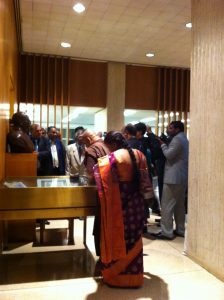
While the statue in Lehman Library does not hold a book in its hand, it is surrounded—and in a way, scaffolded—by books: it inhabits the space of books and of scholarship at Ambedkar’s Alma Mater, Columbia University. It is indeed at Columbia and under the tutelage of many Columbians, including John Dewey, Edwin Seligman, James Shotwell, James Harvey Robinson, and A.A.Goldenweiser that Ambedkar wrote his first paper on caste: “Castes in India: Their Mechanism, Genesis and Development”, and read it at a seminar led by Goldenweiser in the spring of 1916.
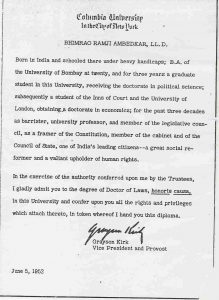 It is at Columbia that many of the ideas animating Ambedkar’s belief in “equality, fraternity and liberty” for all took shape. His teachers helped him develop his thinking and map out his inspiring quest for equality and justice. Much ink has been spilled about the influence of Dewey and of Seligman on Ambedkar, but it is also worth mentioning that the general ethos of the University and the city molded and pushed Ambedkar’s thinking in the directions of intersectionality and critique of systemic injustice around issues of race, class, and privilege and helped him to think through the ideals of a flourishing civil society, equity and social justice for all.
It is at Columbia that many of the ideas animating Ambedkar’s belief in “equality, fraternity and liberty” for all took shape. His teachers helped him develop his thinking and map out his inspiring quest for equality and justice. Much ink has been spilled about the influence of Dewey and of Seligman on Ambedkar, but it is also worth mentioning that the general ethos of the University and the city molded and pushed Ambedkar’s thinking in the directions of intersectionality and critique of systemic injustice around issues of race, class, and privilege and helped him to think through the ideals of a flourishing civil society, equity and social justice for all.
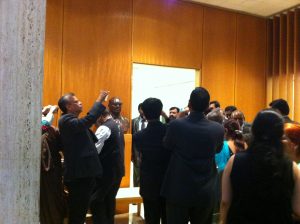 While there is no direct record of the influence of New York and its intellectual ecosystem on his thought, there are certainly many suggestions that it was impacted by other struggles here, e.g. the efforts of Dubois to advocate for racial justice and equality. For example, in the 1940s, when Ambedkar learned of the efforts of Dubois to secure the rights of blacks via the UN Council, Ambedkar contacted Dubois and asked for copies of the letter submitted to the UN so that he could learn from it, noting the similarities between the challenges facing blacks in the US and those of the Untouchables in India. Dubois replied in a very supportive way and stressed that he had “every sympathy with the Untouchables of India” (quoted, with scans of the two letters in an article by Manan Desai published on the South Asian American Digital Archive SAADA website).
While there is no direct record of the influence of New York and its intellectual ecosystem on his thought, there are certainly many suggestions that it was impacted by other struggles here, e.g. the efforts of Dubois to advocate for racial justice and equality. For example, in the 1940s, when Ambedkar learned of the efforts of Dubois to secure the rights of blacks via the UN Council, Ambedkar contacted Dubois and asked for copies of the letter submitted to the UN so that he could learn from it, noting the similarities between the challenges facing blacks in the US and those of the Untouchables in India. Dubois replied in a very supportive way and stressed that he had “every sympathy with the Untouchables of India” (quoted, with scans of the two letters in an article by Manan Desai published on the South Asian American Digital Archive SAADA website).
It is this sense of intersectionality and international, inter-social, inter-racial solidarity that makes Ambedkar’s thinking and legacy so formidable and so relevant to our continued social and scholarly challenges.
In this time of social distancing and isolation, there are many ways to immerse ourselves into Ambedkar’ s legacy, and take heed of his fortitude in bridging and abolishing difference, and in asserting the values of our shared humanity. Here is a list of several resources available through (mostly) remote access for interested readers. Happy Baba Saheb Ambedkar’s jayanti!:
- Ambedkar Initiative at Columbia, Institute for Comparative Literature and Society
- Historical site created by Columbia Professor Emerita Frances W. Pritchett (contains a very interesting historical timeline for Ambedkar’s life and achievements)
- The Columbia University 250th Anniversary celebrates remarkable Columbians
- Columbia University Archives: Notable Columbians Columbia University Libraries
- Columbia Center for New Media Teaching and Learning (now the
Center for Teaching and Learning) contains an annotated version of the work at Annihilation of Caste website
- Several resources from the Internet Archive:
- includes an interesting podcast by the BBC (2017)
- an interesting short documentary by the India Ministry of Information, with interesting archival documents and photos (1981)
- Two interesting lectures by Arundhati Roy on Ambedkar and on Ambedkar and Gandhi:
- the Doctor and the Saint, 2014
- Debunking the Gandhi Myth, the Laura Flanders Show
- Related to intersectional feminism: Dalit Feminist Theory: a reader (access for CUL affiliates only)
- A recent edited collection that discusses Ambedkar in some essays is: Spaces and Places in Western India: Formations and Delineations, edited by Bina Sengar and Laurie Havell McMillin. See chapter 4, “Internet as an emancipatory space: case study of Dalits in Maharashtra” by Sharaddha Kumbhojkar, starting p. 77 which also discusses Ambedkarite influence on YouTube Maharashtra videos, etc. [see p. 80] (access for CUL affiliates only)
- A CLIO keyword search for Dalit Theology (access for CUL affiliates only)
- Ambedkar Center for Justice and Peace [multiple locations in India] (access for CUL affiliates only)
The Columbia University Archives and the Columbia University Libraries hold many resources related to Dr. Ambedkar and to the Dalit movement and Dalit literature. For any inquiries regarding relevant resources, please do not hesitate to contact us: Gary Hausman: South and Southeast Asian Librarian, Global Studies; Rare Book and Manuscript Library: RBML Archivists
Kaoukab Chebaro, Head of Global Studies, Columbia University Libraries, kc3287@columbia.edu
What a great man. Wonderful article.
Thank you very much for sharing these B.R. Ambedkar. At these times, reading is even more necessary. I admire his fight for the rights of the most disadvantaged classes (Castes in India) and his contribution to Buddhism (The Buddha and his Dhamma). A sincere thanks. Health and Ayurveda.
He is good person.
Thanks for such great and insightful info on Dr. B.R. Ambedkar the man who shaped India’s constitution. The reforms that he’s brought about are still relevant to this date. His legacy shall live on forever.
Thank you very much for sharing these Dr. Ambedkar’s Birthday and Legacy. Very Informative article you write